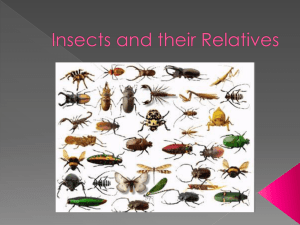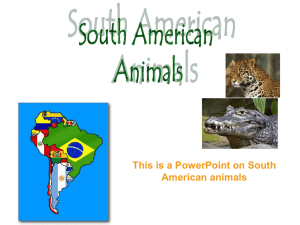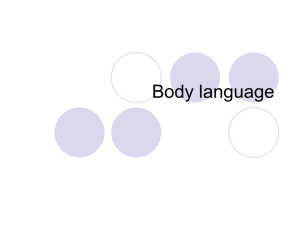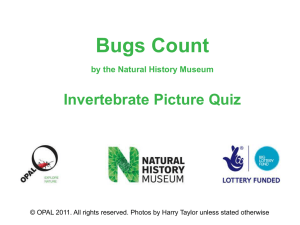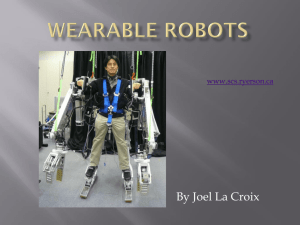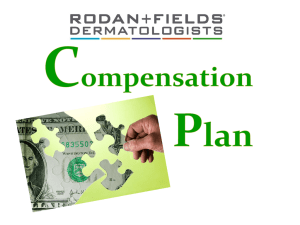Complex invertebrates
advertisement
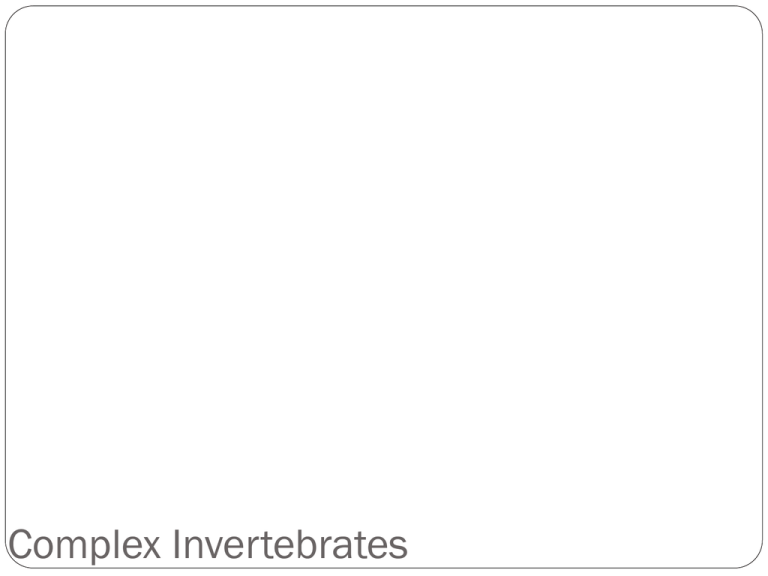
Complex Invertebrates Jointed Leg Animals Ex. Insects, spiders crayfish Have an exoskeleton, a skeleton on the outside of the body make of hard, waterproof, nonliving substances. It also protects body from injury and drying out, and provided a place for growth to occur Bilateral symmetry Have appendages or structures that grow out of an animals body. Examples of appendages are arms legs and antenna. They are jointed to allow for quick movement 80% of all known animal types on earth are Arthropods Molting is a process of shedding an exoskeleton. This is essential for arthropods to grow 5 Classes of Arthropods Crayfish Have mouthparts that hold, cut, and crush food 2 pairs of antennae(appendages on head for sensing smell and touch) Compound eyes for seeing. These eyes have many lenses 2 body sections 5 pairs of legs for walking 1 claw like pair of legs at head for grabing and holding food Spiders and Scorpions 4 pairs of walking legs Simple eyes. These eyes have 1 lense No antennae 2 body sections Feeding mechanism: Trap food in fangs bite into inject poison stun prey eats prey All are dangerous to humans Centipedes Have a head, long segmented body, many legs 100 (centi)feet (pede) 30 legs maximum Appendages on first segment are poison claws used to capture food Eat insects (carnivores) Can be dangerous to humans Millipedes Have a head, long and segmented body 2 pares of legs 1000 (milli) feet (pede) Slow moving Eat plants (herbivores) 2 pairs legs per segment Insects 5th class or Arthropods- more types of insects than all other animals combined!!! Live all over (air, ocean, mountains…) Many shapes and colors Mouthparts varies according to type of food (chewing, sucking, lapping) Body has 3 main parts 3 pairs of walking legs 2 compound eyes and 3 simple eyes 1 pair of antennae Several have wings Only invertebrate than can fly Reproduce sexually by eggs and sperm Have separate sexes Helpful in the following ways Eat harmful insects for food Moths eat aphids that feed on plants Bees carry pollen from flower to flower Bees produce honey Harmful in the following ways Destroy crops Termites eat wood Moths destroy cloths Houseflies carry bacteria and cause disease Spiny skin (ex. Sea urchin sand dollar, starfish 5 part body structure Radial symmetry Has spines Starfish have tube feet suction cups on the bottom of starfish that help it move, attach to rocks, and get food Starfish reproduce sexually with separate sexes by egg and sperm Also reproduce asexually by regenerating arms that are removed Vertebrates Chordates A phylum in which an animal has a tough, flexible rod along its back Live on land or the water Have an endoskeleton- a skeleton on the inside of the body that allows for growth of an organism (unlike and exoskeleton) In most vertebrates, the cord along the back is replaced by a backbone Largest animals on earth Well developed body systems Circulatory system with a heart and blood vessels Digestive system to change food into a useful form Skeletal system for support respiratory system for gas exchange Nervous system for control Large brains, very intellegent 7 classes of chordates Jawless fish Cartilaginous fish Bony fish Amphibians Reptiles Birds mammals General fish characteristics Cold – blooded, or having a body temperature that changes with the temp of surroundings Live in water, breathe with gills. Water is pumped into mouth 02 picked up in gills Excess water leaves through gill slits Most fish have scales to protect their bodies Have fins to help fish to move from side to side when swimming Lateral line runs along each side of the body detects water movement and presence of objects Three classes of fish Jawless, Cartilage, boney 7 Classes of Vertebrates Jawless Fish (ex. Lamprey) No jaws No scales Endo skeleton, cartilage is a tough, flexible tissue that supports & shapes the body Smooth skin No fins Feeding Mechanism: Lamprey are parasites. They attach to other animals with sharp, tooth structures which cut a hole in the skin. They then suck out blood & body fluids. Cartilaginous ex. Skates and rays Cartilage skeleton No bone Tooth like scales on the body Paired fins Sharks have tube like bodies, paired fins, rows of teeth to hold & cut up food Rays are flat, live on the ocean bottom, eat protists & invertebrates in the ocean, most are harmless to humans, but some sting rays have whip like tails that can cause a painful wound. Boney fish (ex perch, bass, flounder) Endo boney skeleton Smooth, boney scales on body to provide protection against enemies & indections. Scales are covered with a slimy covering to help them glide through the water. Have an air bladder, a bag like pouch that fills with gas to allow fish to adjust their depth in the water (go up or down in water) Reproduce via sexual reproduction: the female lays eggs in the water, the male deposits sperm, and the egg gets fertilized in the water. Fertilization & development occur OUTSIDE the mothers body. Amphibians Animal that lives part of its life on land, part in water. (ex. Frogs, toads, salamanders) Young amphibians live in water adult amphibians live on land Adults need to remain in moist areas so skin won’t dry out Reproduce via sexual reproduction Cold blooded (their body temperature can change to the temperature of their surroundings). They also hibernate during cold weather, which means they are sleeping during cold weather, and eat no food & and use very little exygen. They help contain insect populations by eating them Used in medical research, eaten be reptiles, birds, mammals tadpole frog Live in water Live on land, in moist areas Breathe with gills (take in Breathe with lungs O2) Have no tails Have no tails Frogs have a broad mouth with a sticky tongue to catch insects 2 pairs of front legs hind legs more powerful for jumping Webbed feet for swimming Eyes stick out from the head for hunting to catch prey Salamanders have a tail all throughout their lives 2 pairs of legs are the same size Live only in moist places Keep gills throughout life Reptiles An animal that has dry, scaly skin & can live on land. (ex. Snakes, lizards, turtles, crocodiles, alligators) Cold blooded vertebrates Have a backbone & endoskeleton Dry scaly skin protects and prevents water loss Some reptiles skin sovered by scaly plates Well developed lings 2 pairs of legs & clawed toes for running, climbing & digging nests in the soil (snakes & some lizards don’t have legs) Move quickly Reptiles egg has tough, leathery shell to protect it & keep it from drying out Eggs are laid on land Many reptiles live in or near water Eat insects, pests, eats mice Eaten by other reptiles Birds Have wings, a beak, 2 legs & a covering of scales Scales on legs Claws on toes Well developed lungs Young develop inside the female body Adapted for flying, hollow bones, powerful muscles. Some do NOT fly (ex. Ostrich) Warm blooded (they control their body temperature so that it stays the same no matter what the temperature of the surroundings) Feathers help keep the body temperature constant Have beaks to get food Can be helpful to farmers & humans: food source, kill destructive insects in crops Mammals An animal that has hair & feeds milk to its young (ex humans- Homo sapiens) Warm blooded Hair to keep constant body temperature Young feeds on milk produced by mother’s mammary glands—body parts that produce milk Reproduce via sexual reproduction (fertilization & development occur inside the mothers body 3 types of mammal development Inside mother’s body (human) In pouches(kangaroos, opossum) Inside eggs (duck-billed platypus)

